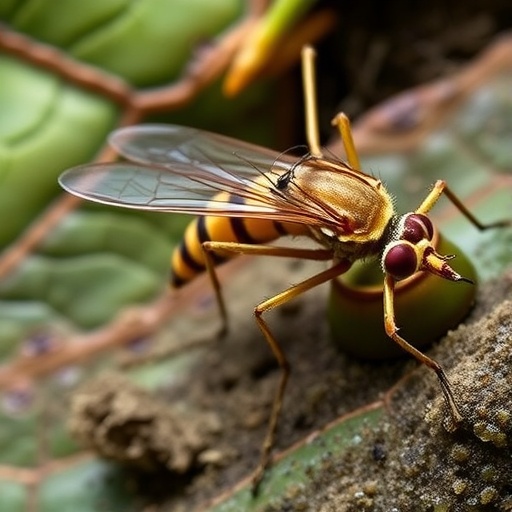
In a groundbreaking study recently published in Front Zool, researchers have delved into the intricate world of centipedes, focusing specifically on the material composition and mechanical properties of their venom-injecting forcipules. The forcipules are specialized appendages that play a crucial role in the predatory lifestyle of these arthropods. Understanding their structural characteristics and functionality is pivotal not only for entomologists but also for materials science and bioengineering fields. This study sheds light on the evolutionary adaptations that allow these creatures to thrive in diverse environments and prey on various organisms.
The forcipules of centipedes are fascinating not just for their role in predation but also for their remarkable construction. These appendages serve as a sophisticated delivery system for venom, enabling centipedes to immobilize prey effectively. The researchers meticulously examined the mechanical properties of the forcipules, revealing a complex interplay between their composition and functional performance. The study’s findings showcase how evolution has optimized these structures for both strength and flexibility, key attributes that enhance their predatory efficiency.
Comprising a unique set of materials, the forcipules exhibit a remarkable combination of hardness and resilience. This study highlights the significance of chitin, a biopolymer found in the exoskeletons of arthropods, which provides structural integrity. However, chitin alone does not account for the mechanical superiority of forcipules. The incorporation of specific proteins and minerals plays an essential role in enhancing their durability and functionality, suggesting an intricate evolutionary adaptation pathway.
One of the key breakthroughs of this research is the identification of how these materials work together under stress. By subjecting the forcipules to a series of rigorous mechanical tests, the researchers were able to simulate real-world conditions that centipedes experience while hunting. The results revealed that the forcipules are not only designed to puncture but also to withstand significant loads without failing. This characteristic is especially crucial in the wild, where centipedes often encounter resistant prey or obstacles that require a robust mechanical performance.
Furthermore, the study delves into the evolutionary significance of these adaptations. The morphological features of forcipules have evolved over millions of years, allowing different species of centipedes to exploit various ecological niches. The research team explored how variations in forcipule design correspond to the hunting habits and habitats of different centipede species. This relationship provides insights into how natural selection shapes anatomical traits in response to specific environmental pressures.
The implications of this research extend beyond entomology and ecology. The mechanical properties of centipede forcipules offer valuable lessons for the field of biomimicry, where scientists and engineers draw inspiration from nature to innovate new materials and designs. By understanding how these natural structures achieve superior performance, researchers can apply similar principles in the development of synthetic materials that require a high strength-to-weight ratio or fatigue resistance.
As the study unfolds, it invites further exploration into the chemical makeup of the venom that these forcipules deliver. The intricate composition of centipede venom is still a relatively underexplored territory, yet its potential applications in medicine and pharmaceuticals are undeniable. The bioactive compounds found in these venoms possess unique properties that could lead to the development of novel drugs or treatments for various conditions. Hence, understanding forcipules is inherently tied to the broader scientific narrative unraveling the mysteries of venomous arthropods.
Moreover, the researchers also suggest that the diversity observed in centipede forcipules could serve as a model for studying evolutionary biology. By comparing the anatomical and material differences among species, scientists can correlate these traits with behavioral strategies, ecological interactions, and evolutionary histories. Thus, this research is not merely a standalone study, but a vital piece of the puzzle in understanding the evolutionary tapestry woven by life on Earth.
For the fundamental understanding of arthropods and their adaptive strategies, revealing the secrets of centipede forcipules can bridge the gap between morphology and functionality. As more studies focus on the relationships between physical traits and ecological roles, the centipede’s forcipules emerge as a poignant example of functional morphology in action. Each finding enriches our understanding of how specialized structures contribute to survival and adaptability in flora and fauna.
The implications of this study could also extend to evolutionary robotics, where researchers are increasingly looking to nature for inspiration in designing robotic systems. By mirroring the function and efficiency of biological appendages like forcipules, engineers could create machines that operate with greater efficacy in dynamic environments. This interdisciplinary approach harnesses the insights gleaned from biological systems, paving the way for innovations that may redefine both robotics and materials science.
In conclusion, this pioneering research into the material composition and mechanical properties of centipede forcipules presents an invaluable contribution to multiple fields of study. As researchers continue to explore the intricacies of arthropod anatomy, the lessons drawn from centipedes provide a framework for understanding adaptive evolution, biomimetic application, and the interplay of structure and function in nature. This comprehensive investigation underscores not only the evolutionary success of centipedes but also the potential it holds for inspiring future scientific advancements.
The study, therefore, illustrates a perfect blend of fundamental research with practical applications, signaling a bright future for the exploration of biological systems in both science and technology. By unraveling the complexities of structures such as the forcipules, we unlock doors to innovative materials and methods rooted firmly in the core of evolutionary biology.
Subject of Research: Mechanical properties and material composition of centipede forcipules
Article Title: Material composition and mechanical properties of the venom-injecting forcipules in centipedes
Article References:
Züger, S., Krings, W., Gorb, S.N. et al. Material composition and mechanical properties of the venom-injecting forcipules in centipedes.
Front Zool 21, 21 (2024). https://doi.org/10.1186/s12983-024-00543-1
Image Credits: AI Generated
DOI: 10.1186/s12983-024-00543-1
Keywords: centipedes, forcipules, mechanical properties, material composition, venoms, evolution, biomimetics, arachnology, structural biology.
Tags: arthropod predation mechanismsbioengineering applications of forcipulescentipede forcipules structurecentipede predatory adaptationschitin in centipedesevolutionary biology of arthropodsinnovative biomaterials from naturematerials science in entomologymechanical properties of forcipulesstrength and flexibility in forcipulesstructural characteristics of centipedesvenom-injecting appendages




